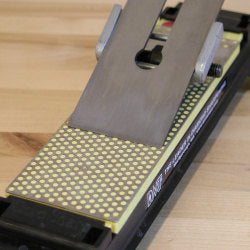Common Mistakes When Selecting a Sharpening Stone
Most Common Mistakes When Selecting A Sharpening Stone
Choosing only a fine stone
The temptation to only purchase a finer stone for all your sharpening needs is tempting. It is the number one mistake that beginners tend to make when selecting a stone. The theory that you can just spend a few more minutes with a fine stone to do the work of the coarse stone is theory that seldom proves successful. A finer stone is only meant to refine the edge of a tool or knife. Removing nicks, sharpening a very dull edge or adjusting the bevel are all done quickly with a coarse stone. A fine stone doesn't just take twice as long, it can sometimes take 10 times longer or even more. In addition, using a fine stone for coarse stone work will wear out your fine stone much faster, ultimately costing you much more than the purchase of a coarse stone.
Our Advice: - Always have a coarser stone. They tend to be less expensive and you never know when you'll need it.
Choosing only a coarse stone
Every tool can have its edge refined with a finer stone. Even a tool such as an axe works better and the edge lasts longer with it is honed with a finer grit stone. A coarser edge is a weaker edge.
Our Advice: - If your budget is tight, we suggest purchasing a less expensive type of stone or an economical combination stone. Having a fine stone along with a coarse stone is more effective than purchasing a more expensive fine OR coarse stone.
Selecting the wrong size stone
A small tool or knife can be sharpened with a large stone but some tools can’t be sharpened on a small stone. Unless you transport your stones often, the larger stones are more convenient to use.
In the case of woodworking tools such as a plane blade, a 2" blade is best sharpened on stones 2 3/4" to 3" wide because the full width of the blade is kept on the stone at all times. However, knife sharpening requires more length than width. While additional width is better, the length of the stone is more important when sharpening larger knives. Because knife sharpening is done in a slicing motion, there isn't an exact length you need for each knife.
Our Advice: - The size of the stone is one of the most important decisions when selecting a stone. For most situations, we recommend a minimum of a 8" size. This is the most common length we sell because it is large enough and still reasonable in price.
| Stone is Too Small | Stone is Well Sized |
|---|---|
 |
 |
View all Sharpening Stones
